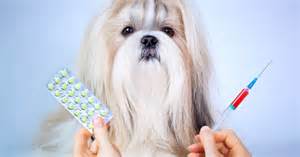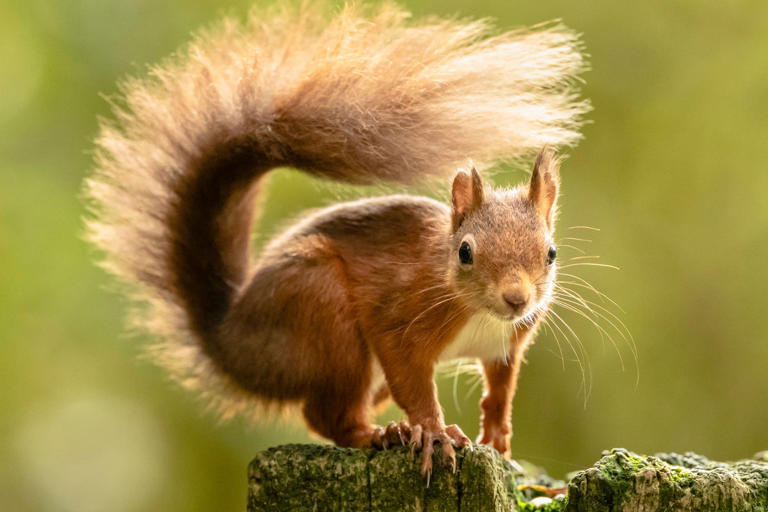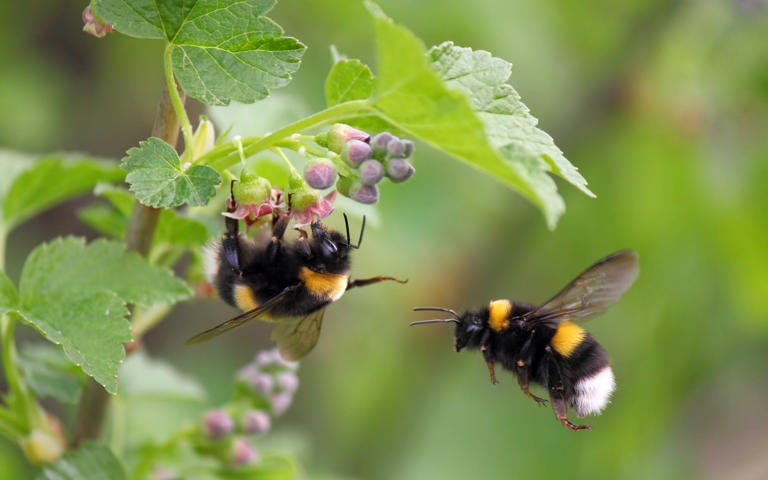Squirrels spread leprosy in 10th and 11th century England





Squirrels spread leprosy in 10th and 11th century England
Leprosy may have spread between red squirrels and humans between 10th and 11th century in England, research suggests.
Evidence gathered from two archaeological sites in the medieval city of Winchester suggests red squirrels may have been a host for Mycobacterium leprae – the bacteria that cause leprosy in people – in the past.
Researchers said although there is evidence this disease has transmitted to humans through infected armadillos, it is the first time scientists have found clues that indicate leprosy was circulating between people and the rodents in medieval England.
Modern red squirrels have also been found to carry strains of the leprosy bacterium, but the team said that these rodents do not pose a threat to people in the UK.
Despite popular myths about leprosy leaping from person to person through physical contact, the infection is not highly contagious.
It is believed to be spread chiefly by coughing or sneezing.
Dr Sarah Inskip, a bioarchaeologist at the the University of Leicester, said: “Very few people are actually susceptible to catching leprosy today and you would have to have prolonged contact with an infected animal.
Leprosy is one of the oldest recorded diseases in human history, which targets the nervous system and causes swelling under the skin.
Although it is rare, the so-called biblical disease still exists today and according to the World Health Organisation, around 208,000 people have leprosy around the globe, mostly in Asia and Africa.
Leprosy can be cured using antibiotics, but if left untreated, can lead to deformity, disability and blindness.
For the study, published in the journal Current Biology, the researchers analysed 25 human and 12 squirrel bone samples gathered the Winchester sites.
Genetic analysis revealed M. leprae to be present in both human and squirrel samples, indicating the infection was circulating between people and the rodents in the Middle Ages.
Verena Schuenemann, a professor for archaeological sciences at the University of Basel in Switzerland, said the medieval red squirrel strain recovered is more closely related to medieval human strains from Winchester than to strains isolated from infected modern red squirrels.
She added: “Overall, our results point to an independent circulation of M. leprae strains between humans and red squirrels during the Medieval Period.”
As Winchester was well known for its leprosy hospitals and connections to the fur trade, the researchers speculate this is how transmission may have occurred.
Dr Inskip said: “We picked Winchester because the sites have squirrel bones themselves.
“There are hand and foot bones (recovered from the sites) – which is what we see when people are processing squirrel skin.
“So that gives us an idea of how humans were interacting with the squirrels in that particular location.”
In the wake of Covid-19, animal hosts are now becoming a focus of attention for understanding disease appearance and persistence
Squirrel fur was widely used to trim and line garments during the medieval period.
Evidence suggests many also trapped wild squirrels as kits in the wild and raised them as pets.
Dr Inskip said: “We forget how much people may have interacted with squirrels in the past and how much they would have been a part of people’s lives and historic sources highlight that quite nicely.
“This is really important in changing people’s perceptions about leprosy being a human-only disease.”
She added: “There is a long history of sharing diseases between humans and animals and they continue to have a big impact on us.
“In the wake of Covid-19, animal hosts are now becoming a focus of attention for understanding disease appearance and persistence.”
Understanding the mechanisms behind embryonic diapause in hungry mouse mums
![]()
![]()
![]()
![]()
![]()
![]()
![]()
Understanding the mechanisms behind embryonic diapause in hungry mouse mums
It's challenging to sustain a pregnancy when food is short, or conditions are otherwise tough. That's why many mammalian embryos can postpone their growth to get through periods of environmental stress and then re-enter development when conditions improve. This stalling of development is known as embryonic diapause, and understanding the mechanisms behind it might help improve infertility treatments, such as embryo freezing. Now, researchers at the Center for Excellence in Brain Science and Intelligence Technology, the Chinese Academy of Sciences in Shanghai, China, have discovered how nutrient depletion is sensed by embryos growing in hungry mouse mums to induce diapause. They publish their study in the journal Development on 11 April 2024.
Lack of food is a known trigger of embryonic diapause, but it has not been clear how nutrient depletion in the mother's diet is sensed by the embryo. "Seasonal starvation is one of the universal environmental stresses in nature," explained Professor Qiang Sun, who led the study. "However, the regulatory process of diapause in early-stage embryos is not fully understood. So, we decided to examine whether nutrient deprivation induces embryonic diapause."
By comparing hungry and well-fed pregnant mice, the team discovered that embryos in the hungry mice did not implant into the uterus and their growth paused at an early timepoint, when the embryo comprises a hollow ball of cells called the blastocyst. These embryos remained viable and could start developing again when transplanted into a well-fed mother.
To work out which nutrients were important to induce diapause, the researchers grew early-stage mouse embryos in dishes that contained different nutrients. They found that embryos grown in dishes lacking protein or carbohydrates paused their development, whereas the embryos exposed to normal nutrient levels did not stall and kept on developing. The scientists then went on to reveal that nutrient sensors in the embryo can detect drops in protein or carbohydrate levels, which triggers the entry into diapause.
The finding that embryos grown without protein or carbohydrates can pause their development means that they can survive longer in the lab. In the future, this finding might lead to improvements in fertility treatments, which currently include approaches such as embryo freezing. "We think our study can inspire the development of new methods for human embryo preservation," said Professor Sun. "Embryo cryopreservation is a widely used approach, but there is still no consensus on when cryopreserved embryos can be thawed and transferred into the uterus. Many clinical studies have shown that traditional frozen embryo transfer can increase the risk of problems during pregnancy. Therefore, it is necessary to develop alternative methods to preserve embryos."
Studies focusing on diapause may even have long-term implications for cancer treatments.
Dormant cancer cells which persist after chemotherapy resemble the diapaused embryos. Consequently, we hypothesize that delving into the mechanism of diapause may have positive implications for cancer treatment and decreasing the chances of relapse."
Professor Qiang Sun
Reference: News Medical
Army reveal update on condition of horses that ran amok in London after surgery
![]()
![]()
![]()
![]()
![]()
![]()
Army reveal update on condition of horses that ran amok in London after surgery
The British Army say the two horses who bolted and ran amok across London are continuing to make good progress.
They confirmed in an update shared today that horses Quaker and Vida were improving. The pair stunned bystanders on April 24 as they ran amok across the city before being recaptured, near Limehouse some five away from where they first bolted.
"Two horses underwent surgery. One, Quaker, a Cavalry black, has shown significant improvement and progresses towards what is expected to be a full recovery," the British Army said in an X post. "The other horse, Vida, a grey, continues to make progress.
"He remains under close and careful professional veterinary observation as his wounds heal. We are so thankful for everyone’s concern and expressions of support, and for all those involved in their care.
"Healing takes time - please be patient as we support that process. The soldiers and horses are all receiving the very best of care."
As reported by the Mirror, the British Army confirmed two of the injured soldiers are still undergoing treatment in hospital although they are expected to make a full recovery. The remainder have since returned to work.
A group of seven horses and six soldiers from the Household Cavalry were undergoing an extended exercise in Belgravia when the animals were spooked by noise coming from a building site. The horses threw four service personnel onto the ground as they ran amok.
Shortly afterward, one of the loose horses ended up smashing into a taxi that was waiting outside the Clermont Hotel, shattering its windscreen. The driver also said a white horse, later identified as Vida, had crashed into a Mercedes people carrier leaving blood splattered down its body.
Jordan Pettitt, 26, said the grey horse was “vividly” stained red with blood and he heard a black horse collide with a taxi. When the horses were recaptured they were taken away for treatment.
Both Quaker and Vida were operated on the night they were recaptured with one being taken back to the barracks and another to an equine hospital. All other horses were closely observed.
Witness Tula, a management consultant from south London, said: "I got off the 172 bus which ends at Aldwych and two horses went flying past. One black, one white. The white one was drenched in blood from the chest down and they were galloping through the traffic at speed.
“People were stopping in the street shocked. The horses were running into fast-moving traffic and seemed terrified. Some unmarked police cars were chasing after them, which didn’t seem to be helping. I felt shocked. It was pretty gruesome. Felt like a weird dream.”
As the British Army shared updates about the horses' condition, a Household Cavalry whistleblower, known by her alias Kate, said the animals were "ready to explode" due to being allegedly kept in poor conditions. "The horses are so nervous," she told LBC. "They are ready to explode. I don't think it's a healthy environment. It doesn't provide what a horse needs, and space."
She also claimed to have seen rats scurrying around about the stalls, loose cables and the horses being given "dirty water," which made them unwell. Kate added the horses would "only have exercise for an hour a day, and very little sunlight."
Bees understand the benefits of teamwork, study finds
![]()
![]()
![]()
![]()
![]()
![]()
Bees understand the benefits of teamwork, study finds
Scientists found that in both tasks, the partnered bees waited for their bee friend to appear before attempting to reach the reward, suggesting they understand the benefits of teamwork.
Dr Olli Loukola at the University of Oulu said: “We could tell the bees were waiting for their partners’ help, as opposed to just pausing, because control bees that were trained to push the block alone did not pause.
“Comparing the partnered bees group against the control group, we concluded that the paired bumblebees were indeed waiting for their partners.
“Based on our observations, we believe they delay moving the block because they think they cannot do it on their own.
“While it’s possible that they want the other bee to share the load or the reward, our experimental set-up was not designed to investigate this aspect specifically.
“Studying their prosocial behaviour is an interesting avenue for future research.”
Bees understand the benefits of teamwork, a study suggests.
Finnish researchers devised an experiment in which bumblebees were taught to push a small brick out of the way, or navigate a tunnel, to get to a tasty nectar treat.
The bees were taught to either carry out the task alone or with the help of a partner.
Species such as chimpanzees, bottlenose dolphins, Bornean orangutans, brown capuchins, Asian elephants, wolves, and spotted hyaenas have shown evidence of actively coordinated collaboration but it was not known if it was possible in insects.
In the past few years, bees have been found to be far more socially intelligent than previously believed.
In March, researchers at Queen Mary University of London showed that the insects can solve puzzles and then pass on the technique to their hive mates.
Bumblebees were taught to nudge a lever, and then spin a floor-plate to access a reward of sugary water.
They were then able to demonstrate the solution to their fellow bees, so that they too could enjoy the treat, even if they could not work out the puzzle themselves.
In the wild honeybees pass on information about the distance and direction of pollen by using “waggle dancing” but the behaviour was thought to be instinctive.
Experts said the finding proves bumblebees possess levels of cognitive sophistication which was thought to be unique to humans, and shows that cultural transmission may be possible among insect communities.
Bees are known to be capable of carrying out complex learned tasks in a laboratory setting, such as pulling a string or rolling a ball to gain a treat. They have been seen playing with balls, seemingly for fun, without any reward on offer.
The research was published in Proceedings of the Royal Society B.





 How to resolve AdBlock issue?
How to resolve AdBlock issue?